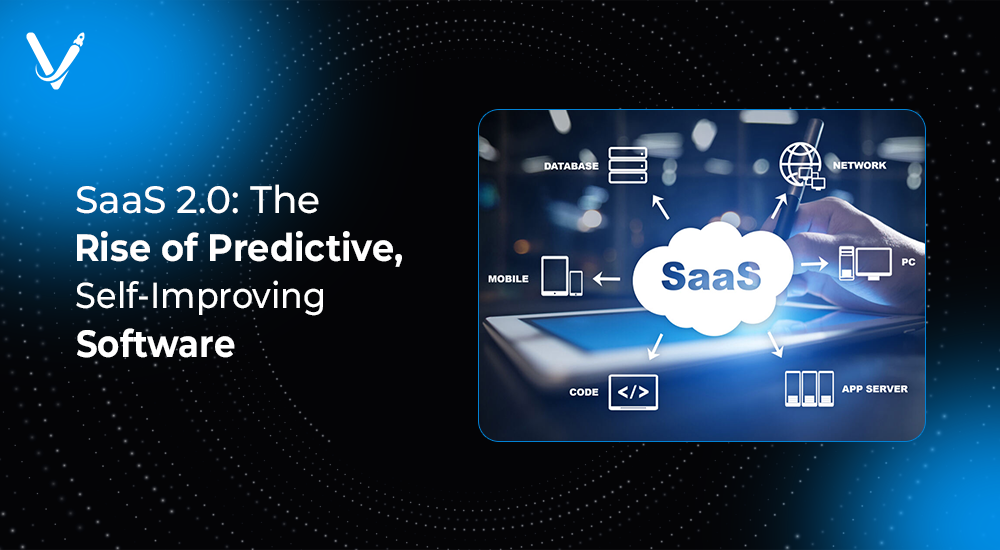SaaS 2.0: The Rise of Predictive, Self-Improving Software


- Jul 24, 2025



The Software-as-a-Service (SaaS) revolution transformed how businesses adopt, deliver, and scale software. Gone are the days of lengthy installation, heavy IT dependencies, and one-size-fits-all interfaces. SaaS gave us agility, scalability, and lower upfront costs.
But we’re now stepping into the next frontier—SaaS 2.0, where software is no longer just cloud-hosted and subscription-based. It’s becoming intelligent, predictive, and self-improving. These next-gen platforms don’t just react—they anticipate user needs, optimize themselves over time, and drive business outcomes proactively.
This blog explores how predictive analytics, AI, and real-time data integration are powering a new breed of software, what it means for businesses and users, and how you can ride this next wave of innovation.
SaaS 1.0 focused on cloud deployment, recurring revenue models, and universal accessibility. While revolutionary, it was largely static in nature—software providers released updates periodically, users adapted to them, and feedback loops were slow.
SaaS 2.0, in contrast, is:
SaaS 2.0 platforms harness predictive analytics to go beyond what’s happening to what’s likely to happen. This unlocks immense value across industries.
For example:
Predictive capabilities empower teams to act preemptively, not reactively, which reduces cost, time, and risk.
The shift here is significant—predictive SaaS platforms act as virtual assistants, driving efficiencies across departments.
The term “self-improving software” refers to platforms that utilize machine learning models to analyze interactions and continuously refine how they operate. This can include:
These improvements are not manually triggered. They happen seamlessly in the background, making systems smarter every day.
Grammarly started as a grammar-checking tool. But through billions of user interactions, it evolved to detect tone, writing clarity, and intent.
Today, its AI:
The more you use it, the better it gets—the hallmark of SaaS 2.0.
With AI-backed insights, businesses no longer need to wait for monthly reports. Dashboards update in real time, highlighting anomalies and trends automatically.
Instead of waiting for issues to be raised, SaaS 2.0 solutions identify friction points and flag them.
This kind of predictive support improves retention and customer satisfaction.
Self-optimizing systems reduce the need for constant manual oversight:
These lead to significant cost savings and performance gains.
At the core of SaaS 2.0 is AI. From Natural Language Processing (NLP) to deep learning, AI enables contextual understanding and predictive capability.
Common AI/ML applications include:
The ability to process and analyze large volumes of data in real time is critical. Tools like Apache Kafka, Snowflake, and Amazon Redshift form the backbone of data-driven SaaS.
With IoT devices generating real-world signals, edge computing enables SaaS platforms to process this data closer to its source, reducing latency and enabling faster predictive actions.
Modern SaaS platforms use behavioral data to customize the interface, recommendations, and workflows per user.
Personalization isn’t a bonus anymore—it’s expected. And it’s driving higher user engagement and loyalty.
In enterprise SaaS platforms like Salesforce, admins can set rules, but AI layers can now personalize dashboards for each team or user based on their usage—reducing noise and boosting relevance.
With AI taking center stage, ethical responsibility is crucial. SaaS providers must ensure:
As SaaS becomes more autonomous, global compliance (GDPR, HIPAA, SOC2) must be built in from day one.
Platforms like OneTrust and Secureframe offer compliance-as-a-service, enabling self-improving SaaS to stay legally sound.
Identify what success looks like:
Your AI model must be trained with the right KPIs in mind.
Use tools like:
Clean, high-quality data is the fuel for predictive features.
Use pre-trained models (like OpenAI for NLP) or build your own with frameworks like:
Match the model to the use case—classification, regression, or recommendation.
Use A/B testing, feedback loops, and performance monitoring. SaaS 2.0 is never “done”—it’s constantly evolving.
Expect more agentic behavior—systems that can plan, decide, and act without being prompted.
Tools like ReAct agents and LangChain are paving the way for AI copilots inside SaaS.
Tools like Retool, Bubble, and Glide now integrate predictive logic, making AI-powered SaaS creation accessible to non-developers.
Composable SaaS is rising—where APIs and AI modules can be mixed and matched across tools for customized experiences.
If you’re still operating on legacy SaaS architecture, you’re missing the next major growth wave.
SaaS 2.0 is not a future vision—it’s the new standard. Predictive, self-improving software is reshaping how we work, sell, support, and scale. The shift isn't just technological—it's cultural.
Businesses must not only adopt these tools but rethink how they operate, measure performance, and engage customers.
At Vasundhara Infotech, we help SaaS companies evolve. From integrating machine learning to building AI-native platforms, our team enables you to future-proof your product and stay ahead of the curve.
Copyright © 2025 Vasundhara Infotech. All Rights Reserved.